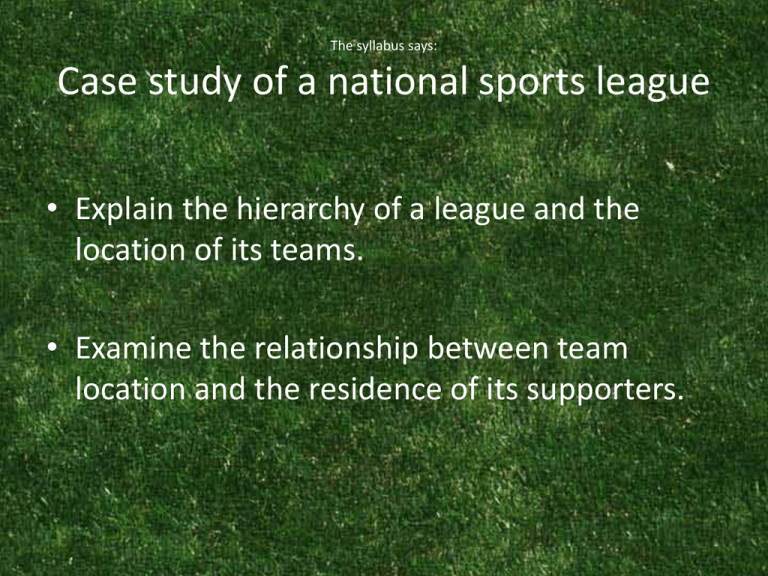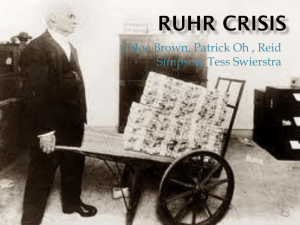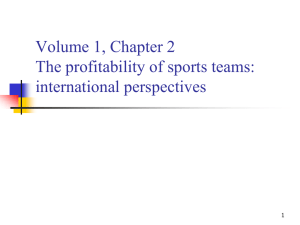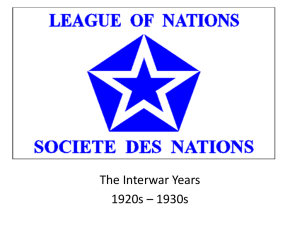The English/Welsh Football League (PPT) - geo
advertisement

The syllabus says: Case study of a national sports league • Explain the hierarchy of a league and the location of its teams. • Examine the relationship between team location and the residence of its supporters. Sports league An organisation that coordinates a group of individual clubs that play each other in specific sport over a period of time for a championship. A league system The UEFA Champions League trophy is when a number of leagues are tied together in a hierarchical system. The best teams are promoted to a higher league, the poorly performing teams to a lower league. A sports division • is a group of teams which compete against one another for a divisional title. The hierarchy of teams often mirrors the location of the teams in the competition. There tends to be more teams at the lower rungs of the league, and these represent smaller, more local areas than the major teams, which often represent larger centres of population or places with a greater drawing area (geographical area) As some sports have become more professional, the traditional relationship between the team´s home area and the area from which it draws its players has broken down. Increased revenue (from TV and sponsorship) has ensured that English clubs can compete on a global scale in terms of transfer fees and wages - an important factor which has seen some of the best overseas players grace the Barclays Premier League. In 1992 there were just 11 nonBritish or Irish footballers in the Premier League, by 2007 this had increased to over 250. Over the years overseas players have helped shape and develop the British game. Overseas managers, too, have been eager to work in England, and techniques used by the likes of Arsene Wenger, Gerrard Houllier and Ruud Gullit have had an enormous impact. df In the same way, the supporters of teams in major sporting leagues are less and less likely to live in the area represented by the team they are supporting. A History of The Premier League It is the world's most watched league and the most lucrative attracting the top players from all over the globe. Hard to believe then that the first ball kicked in the Premier League was as relatively recently as 15th August 1992. The 1980s saw a nadir in English football. Stadiums were crumbling and hooliganism was rife. English teams were banned from Europe following the death of 39 fans at Heysel Stadium in Belgium ahead of Liverpool's European Cup Final against Juventus in 1985. Few of the world's top players would even contemplate plying their trade in England. Then in 1989 came Hillsborough and the Taylor report. 96 fans died and over 150 were injured - crushed during the FA Cup semi-final between Liverpool and Nottingham Forest. 2004 Football League rebranding 2004–05 was the first season to feature the rebranded Football League. The First Division, Second Division and Third Division were renamed the Football League Championship, Football League One and Football League Two respectively. Coca-Cola replaced the Nationwide Building Society as title sponsor. • The Football League, also known as the Coca-Cola Football League for sponsorship reasons, is a league competition featuring professional football clubs from England and Wales. • Founded in 1888, it is the oldest such competition in world football. It was the top level football league in England from its foundation in the 19th century until 1992, when the top 22 clubs split away to form the Premier League. • Since 1995 it has had 72 clubs evenly divided into three divisions, which are currently known as The Championship, League One, and League Two. Promotion and relegation between these divisions is a central feature of the League and is further extended to allow the top Championship clubs to exchange places with the lowest placed clubs in the Premier League, and the bottom clubs of League Two to switch with the top clubs of the Football Conference, thus integrating the League into the English football league system. • The English football league system, also known as the football pyramid England , is a series of interconnected leagues for club football in historical reasons a small number of • Welsh The system has a hierarchical format with relegation (although for clubs also compete). promotion and between leagues at different levels, allowing even the smallest club the possibility of ultimately rising to the very top of the system. • 140 480 7,000 There are more than leagues, containing more than divisions. The exact number of clubs varies from year to year as clubs join and leave leagues or fold altogether, but an estimated average of 15 clubs per division implies that more than members of a league in the English football league system. clubs are Structure • At the top is the single division of the Premier League (which is sometimes referred to as Level 1 of the league 'pyramid'), containing 20 clubs. • Below the Premier League is The Football League, which is divided into three divisions of 24 clubs each: The Championship (Level 2), League One (Level 3) and League Two (Level 4). • The 92 clubs in the Premier League and Football League are all full-time professional clubs. The most successful team in Premier League history is undoubtedly ... Sir Alex Ferguson's side have won a remarkable 11 titles and have never finished below third since the Premier League was launched in 1992. • The system consists of a hierarchy of leagues, bound together by the principle of promotion and relegation. • Clubs that are successful in their league can rise higher in the pyramid, whilst those that finish at the bottom can find themselves sinking further down. In theory it is possible for a lowly local amateur club to rise to the pinnacle of the English game and become champions of the Premier League. • While this may be unlikely in practice (at the very least, not in the short run), there certainly is significant movement within the pyramid. Nowadays, moving between from the Conference and the Football League is a simple annual two up / two down arrangement. Clubs outside this group are referred to as 'non-League' clubs, although they too play most of their football in league competitions. • The top tier of non-League football is the Football Conference, which contains a national division of 24 clubs (Level 5), followed by two divisions at Level 6, covering the north (Conference North) and south (Conference South), with 22 clubs each. • Some of these clubs are full-time professional and the others are semi-professional. • Below the Conference some of the stronger clubs are semi-professional, but continuing down the tiers, soon all the clubs are amateur. • Next down from the Football Conference are three regional leagues, each associated with different geographical areas, although some overlap exists. • They are the Northern Premier League (which covers the north of England and north Wales), Southern Football League (which covers southern England, the Midlands and south Wales) and the Isthmian League (which covers the south east). • All of the leagues have a Premier Division (Level 7) with two parallel divisions below (Level 8). • Level 9 contains the top divisions of a large group of sub-regional leagues. Each of these leagues has a different divisional set up, but they all have one thing in common: there are yet more leagues below them, each covering smaller and smaller geographical levels.






